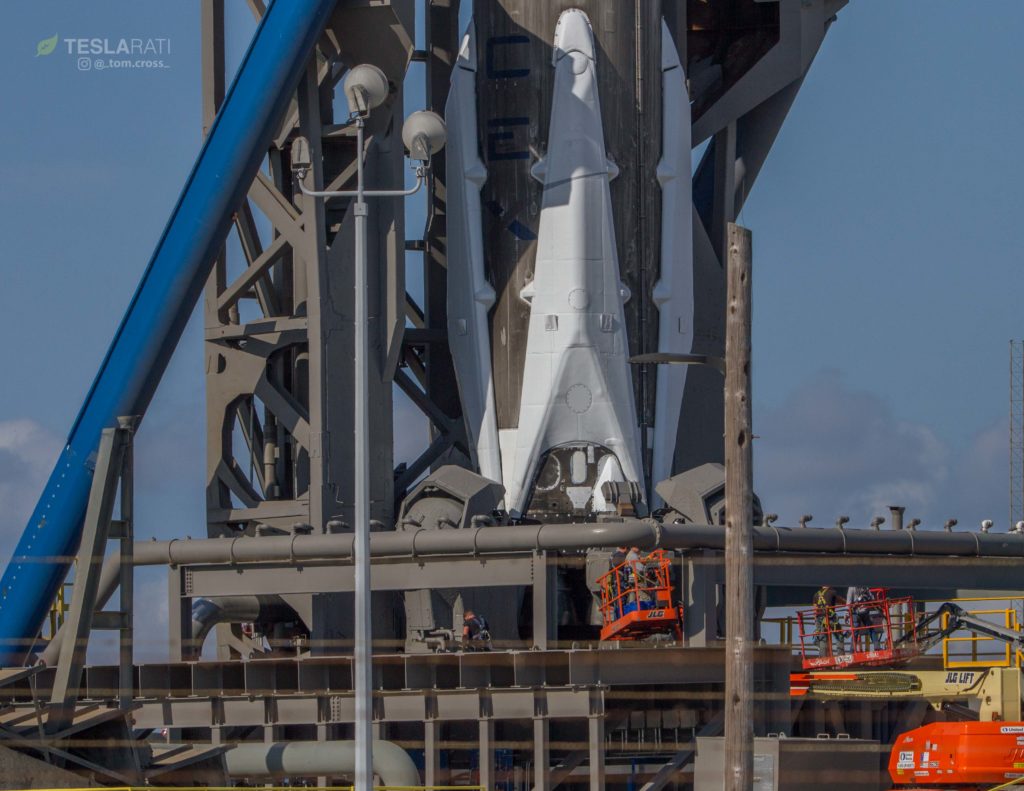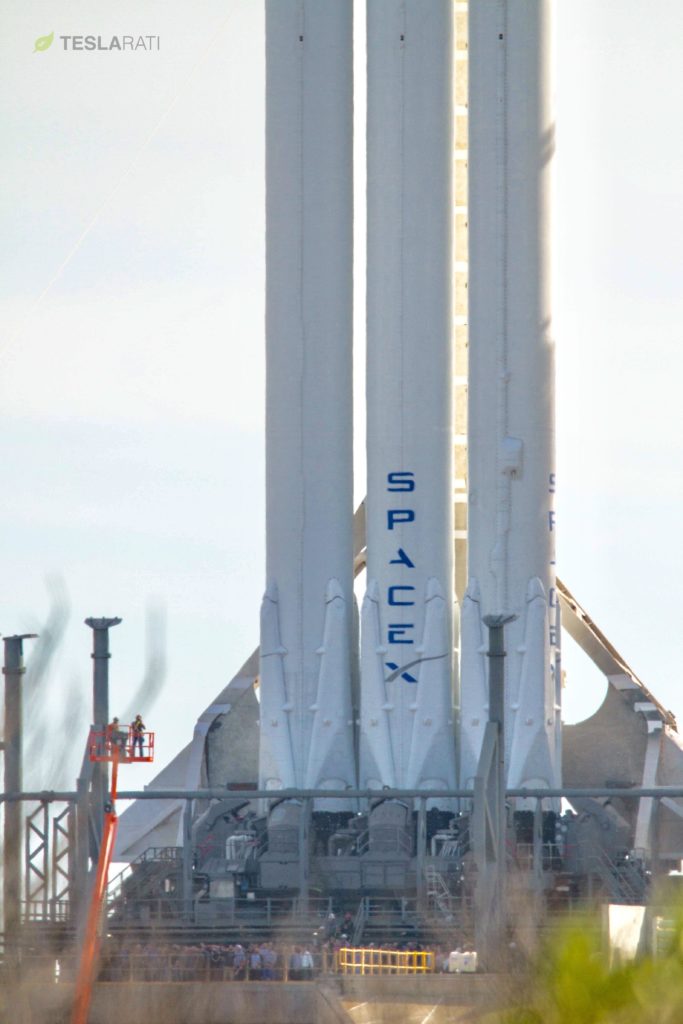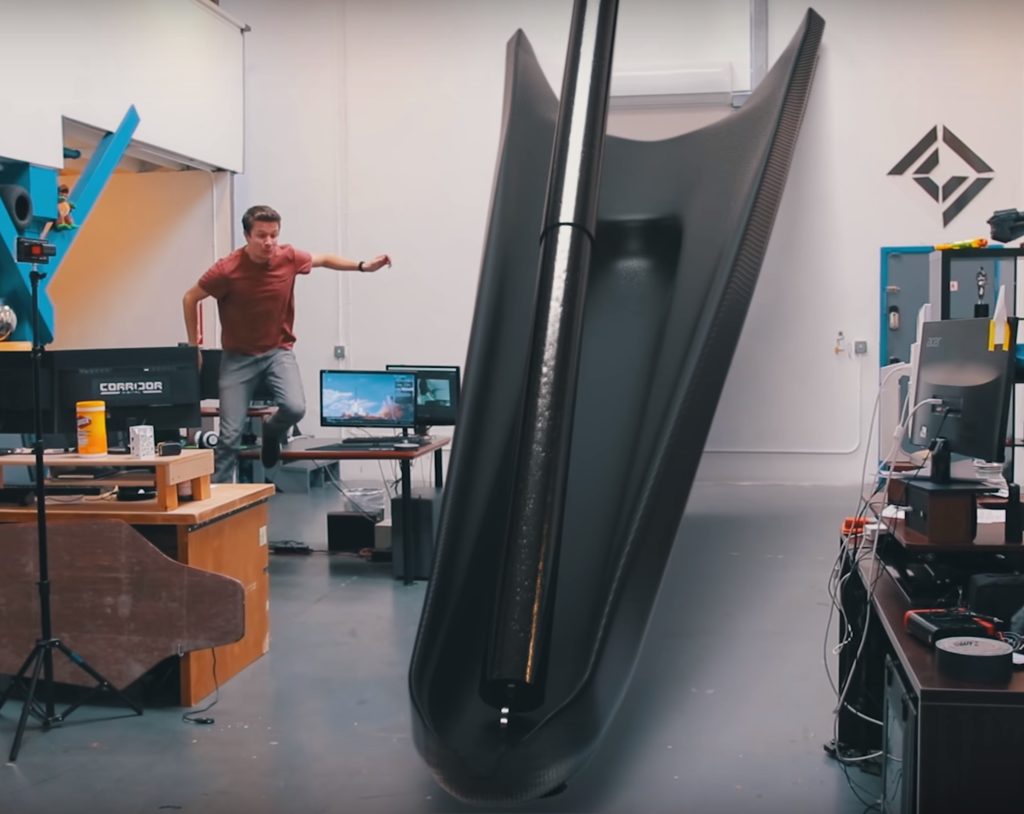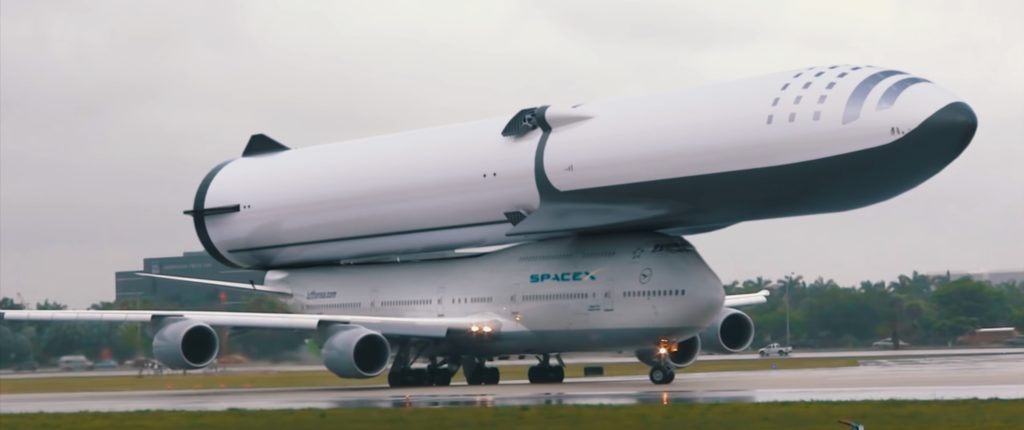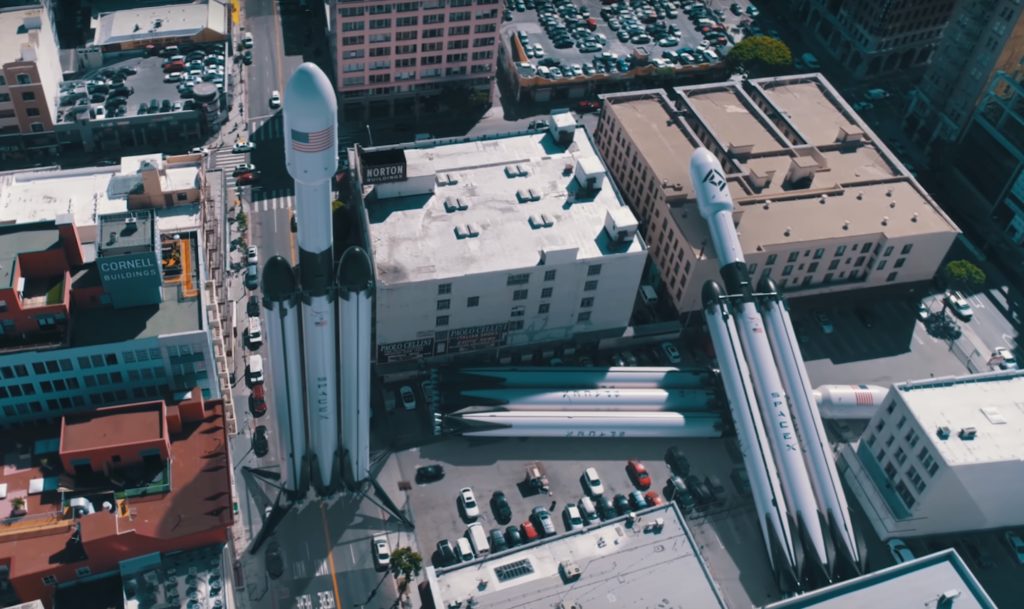
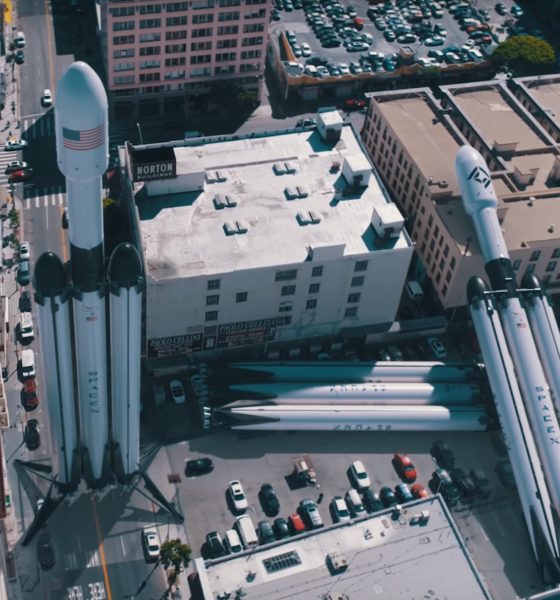
SpaceX
This is how big SpaceX’s Falcon Heavy and BFR rocket is in real life
An artist duo has published an impressive, unofficial look at the true size of SpaceX’s reusable rockets, using a brilliant combination of 3D modeling and animation to really compare Falcon 9, Falcon Heavy, and BFR with recognizable landmarks and cityscapes, lending an incredible sense of scale to the extraordinary feats of engineering that SpaceX routinely launches, lands, and relaunches every month.
In the video, posted on the Corridor YouTube channel on June 19, VFX artist Wren Weichman — known on social media as “sirwrender” — acts as the host of a brief clip where he tours viewers around an office and several cityscapes populated with scale-model 3D renders of all of SpaceX’s various rockets, both those currently operational and those under development. His point is undeniably true: human brains simply are not accustomed to or easily able to build accurate mental pictures of vast real-world objects. The reality almost invariably comes as a visceral shock to onlookers, even those that know better than to trust their perceptual instincts. Be it grand natural wonders or human constructs, humans are quite simply bad at estimating scale until they do so in person.
- SpaceX technicians work at the base of Falcon 9 B1039 ahead of launch, CRS-14. (Tom Cross)
- The scale of Falcon Heavy. (Photo: Tom Cross)
- The hypersonic X-15 and Falcon 9 S1, with a common 737-800 airliner on the right. All vehicles are roughly to scale. (Wikipedia, SpaceX)
With the case of rockets and their launches, this is doubly true and further exaggerated by the fact that launch webcasts, videos, and photos often feature unfamiliar backgrounds of industrial equipment or a perfectly featureless skies, all while almost invariably excluding (for good reasons…) familiarly scaled features like people, cars, animals, or everyday buildings. In many cases, preparations for rocket launches are often the absolute best times available for photos that truly give a sense of scale, as it’s actually reasonably safe to be and work in close proximity to an unfueled rocket.
With the help of models of Falcon 9, Heavy, and BFR created by 3D design Reese Wilson (@AstroReeseW), Wren (@sirwrender) takes those scale shortcomings to task and does his best to create examples with the very cues that average fans and viewers rarely get to see alongside real-life rockets.
- Wren’s example of a rough, uneducated estimate of Falcon 9 legs based on easily available images and livestreams. (sirwrender/astroreesew)
- The full-sized Falcon 9 landing leg is just a smidge larger in reality. (sirwrender/astroreesew)
- A handful of rather absurd cases also serve to illustrate just how huge SpaceX’s rockets are. (sirwrender/astroreesew)
- Just your run-of-the-mill pile of Falcon Heavies in suburban New York City. (sirwrender/astroreesew)
The video really needs to be watched to be fully appreciated – my favorite segment is near the start, where Wren notes that viewers likely expect some of the seemingly insignificant components, projecting a layperson size-estimate of a Falcon 9 landing leg inside his workplace before expanding it all the way to full-scale, at which point the leg literally does not fit inside the office. Visualizations of BFR further show that the crewed Mars rocket will effortlessly dwarf the already massive Falcon 9 and Heavy.
Regardless of whether you were or were not intimately familiar with the actual scale of SpaceX’s many rockets, Wren and Reese make for a seriously entertaining (and educational) combination. Here’s to hoping the duo ventures into more spaceflight and SpaceX videos in the future! Enjoy the video below.

News
SpaceX shades airline for seeking contract with Amazon’s Starlink rival

SpaceX employees, including its CEO Elon Musk, shaded American Airlines on social media this past weekend due to the company’s reported talks with Amazon’s Starlink rival, Leo.
Starlink has been adopted by several airlines, including United Airlines, Qatar Airways, Hawaiian Airlines, WestJet, Air France, airBaltic, and others. It has gained notoriety as an extremely solid, dependable, and reliable option for airline travel, as traditional options frequently cause users to lose connection to the internet.
Many airlines have made the switch, while others continue to mull the options available to them. American Airlines is one of them.
A report from Bloomberg indicates the airline is thinking of going with a Starlink rival owned by Amazon, called Leo. It was previously referred to as Project Kuiper.
American CEO Robert Isom said (via Bloomberg):
“While there’s Starlink, there are other low-Earth-orbit satellite opportunities that we can look at. We’re making sure that American is going to have what our customers need.”
Isom also said American has been in touch with Amazon about installing Leo on its aircraft, but he would not reveal the status of any discussions with the company.
The report caught the attention of Michael Nicolls, the Vice President of Starlink Engineering at SpaceX, who said:
“Only fly on airlines with good connectivity… and only one source of good connectivity at the moment…”
CEO Elon Musk replied to Nicolls by stating that American Airlines risks losing “a lot of customers if their connectivity solution fails.”
American Airlines will lose a lot of customers if their connectivity solution fails
— Elon Musk (@elonmusk) December 14, 2025
There are over 8,000 Starlink satellites in orbit currently, offering internet coverage in over 150 countries and territories globally. SpaceX expands its array of satellites nearly every week with launches from California and Florida, aiming to offer internet access to everyone across the globe.
Currently, the company is focusing on expanding into new markets, such as Africa and Asia.
News
Tesla hints at Starlink integration with recent patent
“By employing polymer blends, some examples enable RF transmission from all the modules to satellites and other communication devices both inside and outside the vehicle.”

Tesla hinted at a potential Starlink internet terminal integration within its vehicles in a recent patent, which describes a vehicle roof assembly with integrated radio frequency (RF) transparency.
The patent, which is Pub. No U.S. 2025/0368267 describes a new vehicle roof that is made of RF-transparent polymer materials, allowing and “facilitating clear communication with external devices and satellites.”
Tesla believes that a new vehicle roof design, comprised of different materials than the standard metallic or glass elements used in cars today, would allow the company to integrate modern vehicular technologies, “particularly those requiring radio frequency transmission and reception.
Tesla has recently filed a US patent application on integrating RF transparent materials into the roof structure.
“facilitating clear communication with external devices and satellites”
Tesla fleet is getting @Starlink connectivity integration soon. LFG @Tesla @elonmusk… pic.twitter.com/bLa8YtPLd1
— Chansoo Byeon (@Chansoo) December 9, 2025
Instead of glass or metallic materials, Tesla says vehicles may benefit from high-strength polymer blends, such as Polycarbonate, Acrylonitrile Butadiene Styrene, or Acrylonitrile Styrene Acrylate.
These materials still provide ideal strength metrics for crashworthiness, stiffness for noise, vibration, and harshness control, and are compliant with head impact regulations.
They would also enable better performance with modern technologies, like internet terminals, which need an uninterrupted signal to satellites for maximum reception. Tesla writes in the patent:
“By employing polymer blends, some examples enable RF transmission from all the modules to satellites and other communication devices both inside and outside the vehicle.”

One of the challenges Tesla seems to be aware of with this type of roof design is the fact that it will still have to enable safety and keep that at the forefront of the design. As you can see in the illustration above, Tesla plans to use four layers to increase safety and rigidity, while also combating noise and vibration.
It notes in the patent that disclosed examples still meet the safety requirements outlined in the Federal Motor Vehicle Safety Standards (FMVSS).
Starlink integrated directly into Tesla vehicles would be a considerable advantage for owners. It would come with a handful of distinct advantages.
Initially, the inclusion of Starlink would completely eliminate cellular dead zones, something that is an issue, especially in rural areas. Starlink would provide connectivity in these remote regions and would ensure uninterrupted service during road trips and off-grid adventures.
It could also be a critical addition for Robotaxi, as it is crucial to have solid and reliable connectivity for remote monitoring and fleet management.
Starlink’s growing constellation, thanks to SpaceX’s routine and frequent launch schedule, will provide secure, stable, and reliable internet connectivity for Tesla vehicles.
Although many owners have already mounted Starlink Mini dishes under their glass roofs for a similar experience, it may be integrated directly into Teslas in the coming years, either as an upgrade or a standard feature.
Investor's Corner
SpaceX IPO is coming, CEO Elon Musk confirms
However, it appears Musk is ready for SpaceX to go public, as Ars Technica Senior Space Editor Eric Berger wrote an op-ed that indicated he thought SpaceX would go public soon. Musk replied, basically confirming it.

Elon Musk confirmed through a post on X that a SpaceX initial public offering (IPO) is on the way after hinting at it several times earlier this year.
It also comes one day after Bloomberg reported that SpaceX was aiming for a valuation of $1.5 trillion, adding that it wanted to raise $30 billion.
Musk has been transparent for most of the year that he wanted to try to figure out a way to get Tesla shareholders to invest in SpaceX, giving them access to the stock.
He has also recognized the issues of having a public stock, like litigation exposure, quarterly reporting pressures, and other inconveniences.
However, it appears Musk is ready for SpaceX to go public, as Ars Technica Senior Space Editor Eric Berger wrote an op-ed that indicated he thought SpaceX would go public soon.
Musk replied, basically confirming it:
As usual, Eric is accurate
— Elon Musk (@elonmusk) December 10, 2025
Berger believes the IPO would help support the need for $30 billion or more in capital needed to fund AI integration projects, such as space-based data centers and lunar satellite factories. Musk confirmed recently that SpaceX “will be doing” data centers in orbit.
AI appears to be a “key part” of SpaceX getting to Musk, Berger also wrote. When writing about whether or not Optimus is a viable project and product for the company, he says that none of that matters. Musk thinks it is, and that’s all that matters.
It seems like Musk has certainly mulled something this big for a very long time, and the idea of taking SpaceX public is not just likely; it is necessary for the company to get to Mars.
The details of when SpaceX will finally hit that public status are not known. Many of the reports that came out over the past few days indicate it would happen in 2026, so sooner rather than later.
But there are a lot of things on Musk’s plate early next year, especially with Cybercab production, the potential launch of Unsupervised Full Self-Driving, and the Roadster unveiling, all planned for Q1.
